
Guide to the Correct Operation of High-Low Temperature Circulation Devices
High-low temperature circulation devices are commonly used temperature control systems in laboratories and industrial settings, providing precise temperature regulation. They are widely applied in chemical, pharmaceutical, food processing, and bioengineering industries. To ensure safe and efficient operation, operators must be familiar with the correct procedures for using the equipment. Below is a guide to help you properly operate a high-low temperature circulation device and avoid potential issues and risks.
1. Preparation Before Starting the Device
Before starting the high-low temperature circulation device, the following preparations should be made:
- Check the power and wiring: Ensure the device is properly connected to a stable power source, and the cables are neither damaged nor aged. The device must be well-grounded to prevent electrical hazards caused by leakage.
- Inspect the heat transfer medium: Choose the appropriate heat transfer medium (such as thermal oil or refrigerant) based on the temperature control range of the device. Ensure the medium is sufficient and not contaminated or degraded.
- Check the liquid level: Ensure the liquid level of the heat transfer medium is within the normal range. A low liquid level can cause the pump to run dry or become damaged.
- Inspect the device condition: Check the pump, piping, seals, and connections for leaks or looseness. Additionally, check that the fans and heat dissipation vents are free from dust or blockages to maintain effective cooling.
2. Starting the Device
Once the preparation is complete, follow these steps to start the high-low temperature circulation device:
- Power on the device: Turn on the power switch and activate the control system. Once the system has completed its self-check, press the start button to begin temperature control.
- Set the temperature: Based on the requirements of your experiment or production process, set the target temperature using the control panel. Ensure the temperature is within the device’s allowable operating range to prevent overloading the system.
- Select the temperature control mode: Some devices offer different temperature control modes, such as rapid heating, slow heating, or constant temperature mode. Choose the appropriate mode to ensure temperature changes meet the needs of the experiment or process.
3. Precautions During Operation
While the device is running, operators should closely monitor the following aspects:
- Monitor the temperature in real-time: Regularly check the temperature readings on the display to ensure they are within the set range. If there are any abnormalities, stop the operation immediately and investigate the cause.
- Check the liquid flow: The flow rate of the heat transfer liquid directly affects the device’s temperature control performance. Monitor the flow indicator to ensure stable flow and appropriate speed. If the flow rate is too low or if the pump is making abnormal noises, stop the operation and inspect the system.
- Check the device condition: Periodically inspect the device for any signs of leakage, abnormal vibrations, or unusual noises. If any issues are found, shut down the device for maintenance to prevent further damage.
4. Shutting Down the Device
After completing the experiment or production, follow the correct shutdown procedures to extend the device’s lifespan:
- Gradual cooling: Do not turn off the device immediately. First, adjust the temperature setting to room temperature to allow the device to cool down gradually. This prevents uneven cooling of the heat transfer liquid, which can create internal stress in the system.
- Shutdown procedure: Once the temperature has dropped to a safe range, turn off the temperature control system and the power switch. Avoid cutting the power abruptly while the device is still hot, as this can damage internal electronic components.
- Drain the heat transfer liquid (if necessary): If the device will not be used for an extended period, it is recommended to drain the heat transfer liquid to prevent it from degrading inside the system.
5. Routine Maintenance
Regular maintenance is essential to ensure the long-term stable operation of the high-low temperature circulation device:
- Clean the device regularly: Keep the exterior and heat dissipation vents clean to prevent dust or debris from blocking the system. Always turn off the power before cleaning to avoid accidents.
- Inspect the seals: Regularly check the seals for wear or damage. Replace any worn or deteriorating seals to prevent leaks.
- Calibrate the temperature control system: The accuracy of the temperature control system is crucial for the device’s performance. Periodic calibration of temperature sensors and controllers is recommended to ensure precise temperature regulation.
- Check the pump and pipes: The pump and pipes are critical components of the device. Inspect them regularly for abnormal noises, vibrations, or blockages, and ensure the pump is functioning properly and the pipes are free of debris.
Conclusion
Following the correct operating procedures for a high-low temperature circulation device not only extends its lifespan but also ensures safety and efficiency in experimental or industrial processes. By adhering to proper operational guidelines and conducting regular maintenance, you can optimize the device’s performance and ensure reliable, precise temperature control in various applications.

